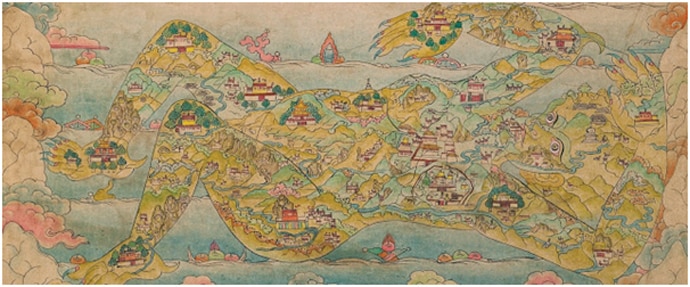How climate is betrayed as India-China spar over the high Himalayas

Tramping along other people's beginnings and ends, the dissident Chinese writer Ma Jian has sympathetically evoked what it means to be an outsider in one's own home, the Tibetan plateaux. This awareness is central to his remarkable collection of stories Stick Out Your Tongue (2006), where Lake Drolma as the piss of Goddess Tadkar Dosangma and her lover the Mountain God of Kailash feature as fearful backdrops, but are rendered complicatedly onto the present.
This is far away from the mystical Hiltonic Shangri-la; and, not too far from the Indian universe of Shiv-Bhakt Mansarovar pilgrims. Buddhism of course travels to China in the first century CE and to Tibet in the seventh century CE when local stories and Indian myths earn entanglement over time in numerous narratives.
In early Tibetan chronicles, dating from at least the ninth-tenth century, the Tibetan landscape (now the Tibet Autonomous Region) is memorably marked as "fenced round by snow, the headland of all rivers, where the mountains are high and the land is pure".
In Tibetan, the "Land of Snow" is Gangjong, the people there the gangchenpa, and the dharmaraja gangchen chogyal. Mountains and adjacent lakes in the texts are married couples.

In the current coupling, Indian media reports have largely transmitted the view that China refuses to give reasons for not allowing pilgrims on the Kailash Mansarovar Yatra to cross the Nathu-la border. More critically minded journalists have, however, cited Chinese "security considerations" and concerns about Indian trespass and chutzpah tilting at their territorial sovereignty.
Chinese media resorts to repeated re-postings of an apparently factual article on BBC's Chinese website, or the official Xinhua produces propagandistic pieces (translated in Global Times). Outlets not directly controlled by the state tend to be fiercer. An article on China.com's "Military Section", entitled Indian Army Should not Mistake Ignorance for Triumph: Remember the Lesson Taught by Beijing 40 Years Ago, reports: "…[T]he Indian media has continuously drummed up [the sentiment that] 'Chinese troops invaded Indian territory'; ...and anti-Chinese Indians even organised the Hinduistic [VHP] meeting, calling for boycotting of Chinese goods".
The two photos that Chinese spokesperson Lu Kang flashed clearly "reveal" that Indian soldiers and vehicles trespassed into Chinese territory, rendering all Indian "excuses" into "jokes" [xiaohua].
Furthermore: "In India, the country of illiterates, India's military always uses its elite troops to brag.
The Indian Army's general idea, however, of "elite criteria" is so base that it is pitiful. We suspect that in the Indian military there are many uncouth fellows [da laocu]..."
How else, can they "completely lack understandings of military topography, not recognising what is called a line of demarcation?"
The piece goes on in this vein: "These kinds, a bunch of low grade Indian soldiers, are made to confront China's military's in theory! The only thing they can accomplish is to lose their country's face."
The comments section of the article airs a form of predominant patriotism reminding the public how mighty China should put India in its place; shenglin ren 282 or "forest person", for instance posts: "The way India does things now, and the state of affairs last time, are the same: India's cabinet and army are wildly clamouring for war. In the end, they were in a sorry plight - beaten. After a couple of decades, India has again forgotten the lesson from that time; the media is again inciting nationalism, and is again pushing India towards the battlefront. Only by teaching them another lesson can [India] mature!"

This ping-pong charge of incursions in the high Himalayas goes back at least to the 1950s if not to the old Great Gamer Younghusband who launched an expedition into Tibet in 1904 from his camp in Kalimpong, not to mention the 1890 Sino-British Treaty.
The consequent concocting of the notorious MacMahon Line, over which the two states have sparred and skirmished, owes much to this truncated history.
The first mythological king of the Tibetans is believed to have descended from heaven onto a sacred mountain like rain fertilising the soil.
Tibet's moral climate is integrally an expression of Buddhist cosmology embedded in respect for the gods of the world, in morally binding relationships. Correlated with a code for proper conduct, nature and society were interacting elements producing a moral space for mundane as much as cosmic communication.
That relationships between human communities and non-human occupants create mutual obligations, has become central for those worried about Anthropocenic extinction, where man as a geological force takes over as the prime mover.
As glaciers melt and streams disappear in the Himalayas amidst nationalistic posturing, while Indian soldiers paint boulders green and Chinese counterparts paint them red in the night, the Third Pole of the Tibetan highlands, and its drifting water politics, is just beginning to warm up.
Pissing, rain, lakes, ganga-jal, shenshui (spirit water), Bay of Bengal, and the Indian Ocean, after all, form an intimately yatric circular. Ultimately, a climatic connect.
(Prem Poddar is Professor in Cultural Encounters at Roskilde University and Confucius Fellow in Shanghai. Lisa Lindkvist Zhang is PhD Fellow in Heidelberg University working on Chinese Philosophy. They are currently co-authoring a book on India-China interactions.)

